The sound at the end tunnel
"Volodya, will be in stock - grab ports for pasikov..." (overheard in one of Moscow's installation studios)
(When the Audio was small and sat under the wing of the Salon AB, published the first two parts of a trilogy about the subwoofers - what to expect different types of acoustic design and how to choose speaker for the sealed box.
A significant portion of those who, pondering life, and I decided be sensitive to bass arming your car, this is, in principle, already could do. But not everything. Since there is at least one, an extremely popular type of acoustic design, not on the prevalence of inferior to the private box.
(The phase inverter in Russian literature, bass reflex, ported. box, vented box - in English - all this, in fact, sound technical implementation of the idea of a Helmholtz resonator. The idea is simple - closed volume communicates with the outside space through openings comprising some mass of air. Here it is the existence of this mass is in the column of air, which, according to Ostap Bender, the pressure on any for the worker, and produces miracles, when the Helmholtz resonator hire in the composition of the subwoofer. Here's a tricky thing behalf of the German physics acquires the prose name of the tunnel (burzujski port or vent) .
How does the phase inverter? Why suddenly the presence in the body of the speaker fine holes of a certain size dramatically affects the whole ensemble? As already mentioned, in passing, in the earlier parts of this epic canvas bass reflex tunnel is used for, holding on certain times of the sound wave that occurs inside the box speaker, let her out at the same stage of that and created a "face" party dynamics. Here, in the wild, they will combine their decibels and will give the ears (with proper calculation) so that will not find it. This is, in fact, the phase inverter and love - for the higher, compared with the closed drawer, D. K. p.
But not only. Brute force is not an argument, if not supported by precision the playback signal. This refers to the other, considerably less trivial feature of the phase inverter is his ability to produce the required sound pressure level at a much lower amplitude of the diffuser. It sounds somewhat paradoxical. Everyone knows that it is the presence behind the diffuser the closed volume restrains fluctuations of the diffuser, so why in the "leaky" the case they will suddenly become less? And because of the mass, as was said. Hole in the case of vasodilator therefore made as long tunnel - pipe, simply put, to keep within a certain mass of air. On relatively high frequencies above 200 Hz, the inertia of the air mass in the tunnel leads to the fact that he completely acoustically opaque. As if clogged really.
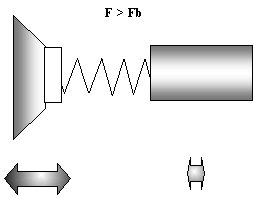
Below the frequency of the air tube in the tunnel begins to come alive and move, since her back was pushing policyrule inside the box pressure. The inertia of the air mass leads to the fact that it is not moving in rhythm with the current wave at her, but with some shift. This shift reaches 180 degrees in phase, that is, begins to be anti-phase sound wave emanating from the back side the diffuser at a certain frequency, which is called the tuning frequency bass reflex.

Here almost all the efforts of the dynamics going on rocking intractable air mass inside the tunnel, so that the natural oscillations of almost nothing remains and amplitude fluctuations of the diffuser is minimal. (And the sound goes, but still what! Just at that frequency it's almost coming out of the tunnel). And because large amplitude oscillations of the membrane and give rise to noticeable distortions - the decor in the sense of the sound comes the most favorable.
Even lower frequency case, however, begin to change for the worse.For very slow low-frequency oscillations, the mass of air in the tunnel is already no inertia and the back side of the diffuser shakes it back and forth as a pump.
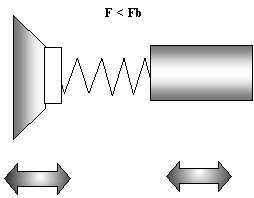
In this case, as if the speaker is not fitted in the housing, that is, the waves from the back side of the diffuser and front meet in antiphase and largely each other eat as normal acoustic short circuit. Therefore, lower frequency tuning will return bass reflex and falls twice faster than the sealed box. Worse, however, another diffuser nothing slows down and the vibration amplitude at all low checotah begins to grow catastrophically. Podonominae filters (subsonic filters), which supplies some, usually purebred, crossovers and amplifiers, made almost exclusively to counteract this harmful the habit of inverters.
So, what we own, once you put your project bass-reflex acoustic design? ( (I want to warn - the calculation of the phase inverter without a designated computer programs - possible for him and there are formulas and nomograms. However, on the threshold the third Millennium to qualify such methods as otherwise masochism, I can't.
Here is a picture that explains (almost) all. Taken 10-inch speaker, which parameters suitable for installation in vented and simulated characteristics which are obtained when seated in the optimal phase inverter (20 liters, tuned to 42 Hz) and same for the volume of a closed box.

The upper of the two black curves, of course, ours. Compared to a closed box, throughout the band of frequencies below approximately 150 Hz return is significantly higher. What does it mean "substantially"? Take a look: at a frequency of, say, 60 Hz the difference is about 4 dB. But this is equivalent to increasing the power of the amplifier 2.5 times. That is, with a modest 100-watt amplifier this subwoofer will play as if it was delivered to it 250 watts. For the same money.
But the red curves depicting the dependence of the amplitude of oscillations diffuser frequency ours is lower. Right there, where a big part of bass energy below 100 Hz, the amplitude begins to fall and remains much lower than that of the sealed box, although the generated sound pressure - twice!
The closed box of the amplitude of the oscillations grows steadily and summing the power that is specified as a maximum, beyond working range (red dotted line) to 70 Hz and below all the trouble. There will be generated on such familiar hearing the rattles accompanying the bass notes. I bass reflex grace with the amplitude goes down to about 30 Hz, and there the amplitude begins to grow're the restless hearted. However, there already and the sound-that almost no no, so direct meaning "to strangle" this part of the spectrum filter podvalnym (if you have one) and enjoy the shock efficiency with minimum distortion in really sound range.
"Cool!" - cry impatient and eager for decibel reader, will close these pages will be sent immediately to get on the gaps in your own subwoofer. Comrade, wait! Look what can to happen next. Let, leaving everything unchanged, we will turn from our a 20 litre box former speaker and install the other intended for work in a sealed enclosure.
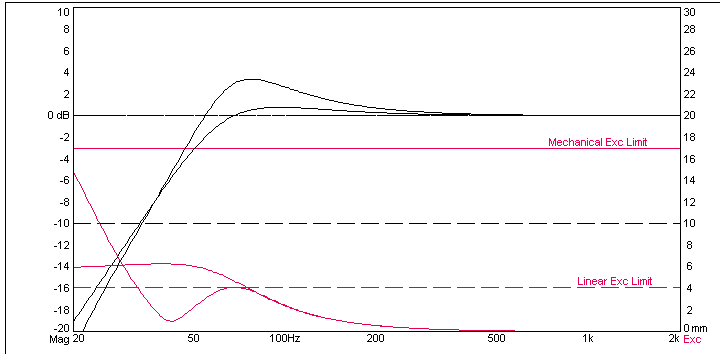
Its characteristics in a closed, native box - bottom on the chart - was very nice. And after the alteration in the phase inverter she would be like top, that is, give a pronounced "Hapon" between 50 and 100 Hz. In the establishment of such combinations phase inverters received in his time insulting nickname boom-box ("booze"), later used, this time quite true, for some portable audio players.
What was the difference between the two speakers? In two settings, which must be in a certain harmony for a given acoustic design, otherwise ostati hope ye who enter here cymbal, so to speak. These settings - the resonant frequency Fs and total quality factor Qts.
"Dynamics of the closed they were Fs=25 Hz, Qts=0.4 a. And "bass reflex" - 30 Hz and 0.3. Like not so big difference, and the results are significantly different. Invented at the time, the energy parameter bandwidth Fs/Qts immediately shows who is who: implications for dynamics of the first 62,5, and for the second 100. The rule is simple - if Fs/Qts noticeably smaller 100 - forget the word "reflex". If it is close or more - again, remember, and forget about a sealed box. Around 90 - 100 - "the twilight zone", where, with the known concessions can be applied.
What will happen if to insist on and to push the speaker into the uncharacteristic making? Let's try, good bye drama takes place on paper and the computer screen, that is "a little blood, it's territory".
To begin, put "bass reflex speaker in a sealed box and try to vary the only parameter that have a volume of this box.
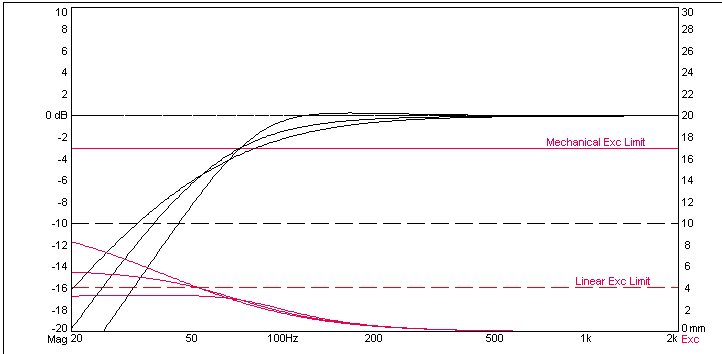
For the three curves. The most gentle - installed in the box volume 50 liters, the steeply falling below 100 Hz when the volume of the box 10 And L. in the middle is our initial characterization of a 20-liter volume. See: volume changes from filthy little impractical to big and worthwhile characteristics goes wrong or she begins to subside too early or subsides too fast.
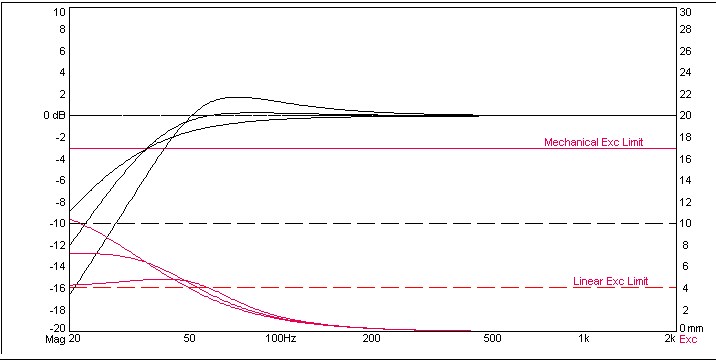
Speaker, born private box, as can be seen from the following graph, there is an opportunity or to get to the optimum (middle curve) or "nacrite" volume, receiving quite significantly "gakushuu" feature (top curve obtained in a volume of 10 liters).
And Vice versa? Is it possible when "closed" dynamics in the phase inverter so to set it up to get a flat frequency response? Theoretically, Yes, the benefit of the bass reflex can at constant scope to rebuild the frequency by changing the diameter and the length of the tunnel (in practice always the length, of course). Start the experiment with top, totally awful curve (capacity of 20 litres, this frequency is 50 Hz) and gradually, reconstructing the phase inverter, suddenly, at a frequency of 20 Hz, notice that came to a very nice curve (lower graph).
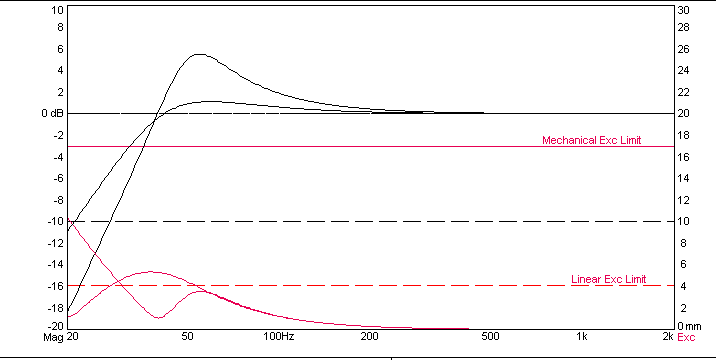
Yikes, let us now calculate the tunnel for this need - and more! After a half-second of computer time we find that in order to set 20-liter volume at a frequency of 20 Hz, you need a tunnel with a diameter of 75 mm and a length of 1 m 65 see That is the size of a petite lady, and not to the detail compact the subwoofer.
But while the "bass" speaker will allow with minimal hassle (push the tube - advancing pipe) to rebuild chastotu not worse than EQ. The graph - the results of such activity in the frequency range tunnel settings from 35 to 52 Hz, which took the tunnel length from 190 to 400 mm - not much even at the greatest value.
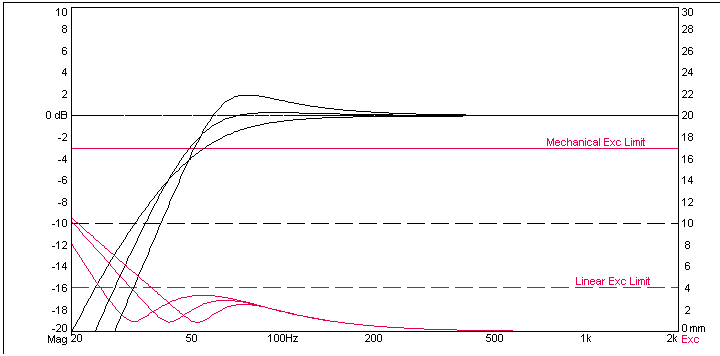
In the next part of the Saga of subwoofers (of course, not the last - theme boundless, but God is merciful and possibly prolong the years of the author), we will already have directly the question of the implementation of the planned - for those who want to do it myself, or for those who want to be able to distinguish a a competent installer from ignorant attempts culturally. Agree - even while riding in a taxi is useful to know that the path from Falconers in Izmailovo takes something away from Chertanovo...
Author: Andrew Elyutin, Autosound; Publication: www.avtozvuk.com, www.cxem.net






